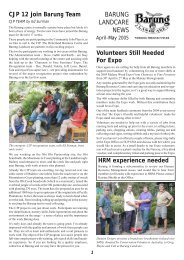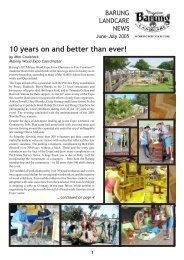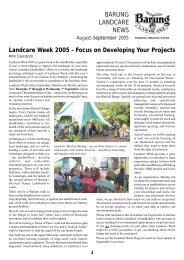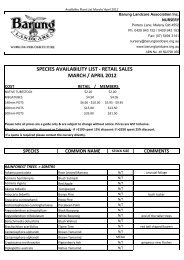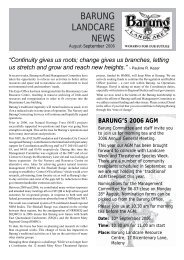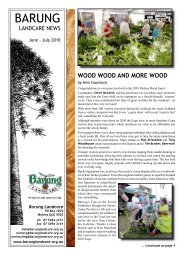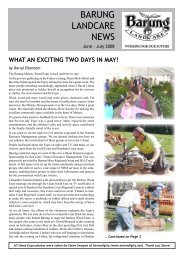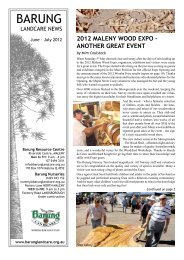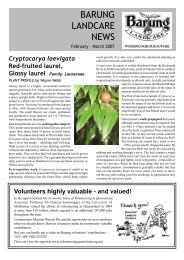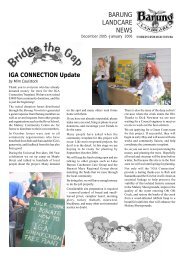Apr/May 2007 - Barung Landcare
Apr/May 2007 - Barung Landcare
Apr/May 2007 - Barung Landcare
You also want an ePaper? Increase the reach of your titles
YUMPU automatically turns print PDFs into web optimized ePapers that Google loves.
For the Frugivores<br />
THE ORNAMENTAL GARDEN by Joan Dillon<br />
We’ve had some less common garden visitors lately; two<br />
female regent bowerbirds. We occasionally catch a glimpse<br />
of the gorgeous black and gold male but he doesn’t usually<br />
come so close to the house. The females were attracted by<br />
the fruit on a Decaspermum humile and I was reminded of<br />
the importance of fruiting trees and shrubs to many of the<br />
local birds. Decaspermum with its small leaves and neat<br />
habit is a useful addition to any garden.<br />
Our assorted figs in the revegetation/regeneration always<br />
support a range of pigeons from the wompoo down to the<br />
little greenwings, plus a substantial flock of figbirds and<br />
increasing numbers of lorikeets. The lorikeets are also<br />
attracted to the tiny sweet fruit on the native mulberry<br />
Pipturus argenteus, which the birds do love it as a source of<br />
small insects as well as fruit. Honeyeaters and yellow robins<br />
search amongst the leaves and twigs for tiny caterpillars.<br />
A pioneer species which attracts the brown turtle doves to<br />
its fruit is Homolanthus populifolius, and crows (ravens)<br />
seem to like the fruit of Macaranga tanarius. The bright<br />
purple fruit of Callicarpa pedunculata is both decorative<br />
and popular, as is the creamy coloured fruit of Psychotria<br />
loniceroides. This one comes up all over the place and<br />
I suspect the Lewin’s honeyeaters are responsible for<br />
spreading it. The brush turkeys took a liking to the blue fruit<br />
of Dianella congesta, and just about stripped the plants.<br />
Callicarpa pedunculata fruit. [Photo by Ian Dillon]<br />
Something is enjoying the fruit of the Davidson plum as I’m<br />
finding pecked fruit on the ground, and I’m waiting to find<br />
out what will be attracted to the Acronychia oblongifolia,<br />
now flowering heavily. Varied trillers love the fruit of the<br />
red bean Dysoxylum mollissimum (Dysoxylum muelleri) and<br />
seasonal visitors like the black-faced cuckoo shrike move<br />
from fig to wild raspberry and back again.<br />
The native olives Olea paniculata fruited heavily last year<br />
and kept the figbirds fed for weeks. When I went to collect<br />
some rosewood seed for propagation it was all gone and<br />
there was none on the ground. Something had dined well.<br />
Adding figs to the revegetation mix provides fruit for flying<br />
foxes as well as birds and hopefully reduces the impact on<br />
local orchards. Our resident and visiting frugivores provide<br />
endless pleasure and entertainment and help to disperse the<br />
local species.<br />
<br />
More about the IBISCA<br />
Lamington Project<br />
by Gretchen Evans & Lin Fairlie<br />
Not insects this time, but macrofungi<br />
Last issue of <strong>Barung</strong> News, Petrus wrote<br />
about the IBISCA project. This time we<br />
would like to tell you about an associated<br />
project in which we have been involved,<br />
called BATH – Biodiversity at the Heights.<br />
We are both members of Queensland Mycological<br />
Society (QMS) and have participated<br />
in two macro-fungal surveys, one last<br />
November and one recently in February.<br />
All the 20 sites were not covered because there were only 13<br />
volunteers and 3 days in which to do the surveys. Also there was<br />
only one professional mycologist, Nigel Fechner, who is half-time<br />
on macro fungi at the Queensland Herbarium, but a number of<br />
our colleagues were very knowledgeable.<br />
During our recent visit we discovered, photographed and<br />
described about 150 different specimens. As each new fungus<br />
is found, detailed descriptions of its size, colour and substrate<br />
are recorded and photographs taken. Then, after an identifying<br />
number has been assigned to the specimen, it is collected and<br />
returned to base for further description. Many fungi were really<br />
beautiful with varying colours, shapes and textures. Many were<br />
of the ‘mushroom’ type, but we did find some rare ones such as<br />
a Mutinus sp., which is a type of ‘stinkhorn’, and another which<br />
has never been found in Queensland before, a Chlorosplenium sp.,<br />
which was a beautiful bluey-green ascomycete or cup fungi.<br />
Unfortunately there are ‘weed’ fungi too. We found quite large<br />
infestations of Favolaschia and the spread of this fungus certainly<br />
needs research. However there is very little money available for<br />
macrofungal research, even though there is a growing recognition<br />
of the association between many individual Australian tree<br />
species and specific fungi.<br />
QMS has a regular monthly meeting at 7 pm on the second<br />
Tuesday of each month in the Herbarium lecture room at the Mt<br />
Coot-tha Botanical Gardens. Everyone is welcome. Sunshine<br />
Coast members are planning outings later in the year to look for<br />
local fungi, so we will keep you informed of dates and details.<br />
Driving into <strong>Barung</strong><br />
Sloooowly, please<br />
If you need to bring your vehicle into <strong>Barung</strong><br />
(instead of parking outside), PLEASE drive<br />
very, very slowly and carefully.<br />
The dragons are very nimble, but small children<br />
who may be visiting the plant nursery<br />
don’t have such quick and instinctive reactions<br />
for avoiding vehicles (or any at all,<br />
really).<br />
Please keep <strong>Barung</strong>’s driveway safe.<br />
Drive sloooowly.



